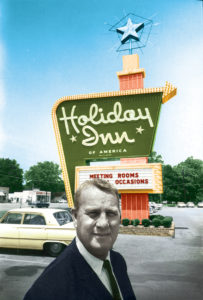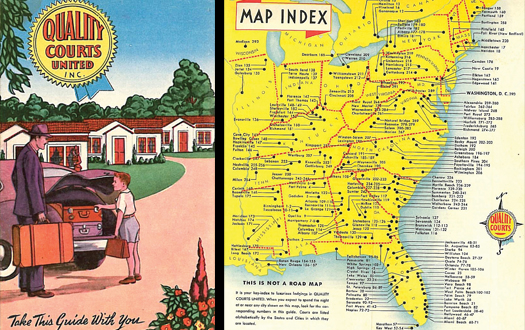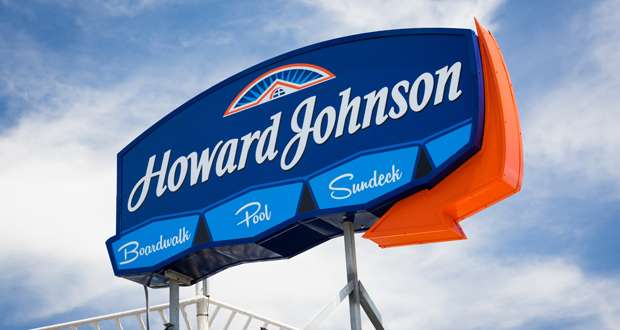The origins of hotel franchising can likely be traced to the formation of a quality-standards-based marketing cooperative by seven motor court owners nearly 80 years ago in Florida. What began then as Quality Courts United is now Choice Hotels International, which franchises more than 6,500 hotels. Now part of InterContinental Hotels Group (IHG), Holiday Inn entered the space in 1951, when Kemmons Wilson decided to create what he could not find during a family road trip from Memphis to Washington, D.C.—reasonably priced, clean and comfortable motel rooms where kids (he had five) could stay at no additional charge. And, Wyndham Hotel Group’s most historic brand, Howard Johnson, began in 1954 as Howard Johnson Motor Lodges, when the popular restaurant chain known best for its ice cream and fried clams leveraged its reputation for consistent food quality and successful restaurant operation to expand into lodging.

These formidable forces in the hotel industry have grown and changed dramatically, as representatives from these organization plus longtime hotel owners and managers, William Meyer and Richard Jabara, explained to LODGING.
Second generation hoteliers—their fathers were co-owners of various Holiday Inns in the 60s—William Meyer and Richard Jabara have seen enormous changes in the hotel industry, especially in franchising structure and operation, since founding Meyer Jabara Hotels some 40 years ago. As chairman and president & CEO, respectively, of a firm devoted to owning and managing hotels, Meyer and Jabara saw the transition during those years first-hand.
Regarding this markedly altered scene, Meyer considers the most significant change during his own years in the business to be the proliferation of new brands within individual franchisors. “Back in 1977, when we entered the business, there were just a handful of major franchisors, and there was no such thing as limited service and select service,” he comments. Jabara recalls the power the franchisors had back then, when he and Meyer purchased their first property, a Holiday Inn in Danbury, Connecticut. “There was just one brand and it was theirs. They operated on the assumption franchisees needed only to use their blueprint and implement their programs—including kids eat free—to succeed.”
But, to understand how and why hotel franchising developed as it did and how franchises have changed in response to all involved—guests, franchisors, and franchisees—and, perhaps most of all, technology, you have to go back further.
Where It All Began
It is no surprise that the development of the interstate highway system coincided with the rise of motor lodges. These events impacted not just the proliferation but also the location of lodging for families, who took to these new superhighways in record numbers to explore the country.
Tim Shuy, VP of owner and portfolio strategy for Choice Hotels International, describes those first steps taken in 1939 by Quality Courts to establish for its members standards with respect to physical facilities and operating practices. “Back then, it was more of a co-op type of arrangement whereby owner members complied with standards and referred business to one another.” But the organization became more formalized as its reputation and membership grew in response to consumer demand during the following decades. “Families began travelling by car, and they needed comfortable places to stay. Hotels with the Quality Courts designation promised adherence to those standards,” explains Shuy.
Beginning during its days as Quality Courts—still made up of independent owners of different types of hotels—it evolved to function as the country’s first hotel chain, becoming a for-profit corporation called Quality Courts Motels, Inc., in 1963, and the largest association of independent motel operators in the world in 1969.

Early Innovations
Shuy cites numerous introductions by the company under the stewardship of Stewart Bainum, Sr., originally a Washington, D.C., plumbing contractor, who is considered the founder of Choice Hotels International. Keeping the business within their family, says Shuy, Bainum’s son, Stewart Bainum, Jr., eventually became chairman of the Board of Directors and helped keep the company at the forefront of the industry. “Choice was the first to offer to the industry such innovations as wall-to-wall carpeting, daily change of linen, 24-hour desk service, and in-room telephones,” he says. Although later firsts would be no-smoking rooms, 24-hour-a-day, toll-free reservations, an Internet-based property management system, and a global hotel application for use with the iPhone, the inn-to-inn system he describes was a game changer at the time. “They used long cylinders representing the number of miles between affiliated hotels, and there was a posted number to call from the lobby.” Continuing with a legacy of innovations, adds Shuy, Choice recently introduced choiceEDGE, the first new global reservation system from a hotel company in over 30 years.
According to Chris Drazba, VP, North America Core Brands & Mexico Development at IHG, Holiday Inn’s contribution to the early method of connecting properties with guests and one another included its launch of Holidex, a centralized reservation system modeled after the airline industry’s Sabre; it enabled Holiday Inn visitors to obtain reservations by teleprinter for any other Holiday Inn location. They also created a call center after AT&T introduced 1-800, toll-free telephone number service and, soon after travel agencies, adopted desktop microcomputers.
Franchising Model Takes Hold
What became the dominant franchising model—which was ultimately adopted by Bainum’s properties as well—went beyond adhering to standards, to strict standardization in nearly all regards. Cynthia Liu, vice president of operations for Howard Johnson, describes the “rigorous franchising model” its early franchisees adopted to be part of “an orange-roofed empire of restaurants and hotels, creating the iconic brand so many know and love today.” The advantages of franchising in the days before online travel agencies, internet comparison shopping, and a dizzying variety of options for travelers seemed clear. “In the early days of franchised hotels, having consistent, value-priced accommodations was, in and of itself, a novel idea that, executed successfully, allowed brands to flourish,” explains Liu. Drazba concurs, “As a guest, you knew what to expect when you pulled up to the familiar Holiday Inn building, whose model remained intact through the 50s, 60s, and 70s, complete with familiar buildings, signage, and posted vacancy and room rate sign.”
Drazba notes, too, that franchisors and franchisee then had clearly defined roles and responsibilities in terms of creating and delivering that product. The franchisor was charged with supporting franchisees with an effective reservation system, national advertising to market its benefits and latest programs, and otherwise delineate and support its formula for success.
Competing In Changing Times
But, as competition increased, so did the need to “break through the clutter” —i.e., differentiate—while adapting to the realities, including that buildings designed for the days when they were largely alone at their location, were no longer practical. (Holiday Inn responded by scaling down their buildings in some markets to make the hotels smaller and more efficient.) It is likely for this reason, says Drazba, that franchisors began to invest heavily in consumer research, which they used to continue to differentiate the guest experience through selection of a whole variety of amenities, designs, and food and beverage offerings.
As Liu observes, in this increasingly crowded landscape, competing meant providing more than value and consistency. “The emphasis shifted to providing a differentiated experience that truly speaks to the needs and wants of guests,” says Liu. She notes the role of design in the guest experience, including its current Howard Johnson brand-wide “refresh” called Renew. “It’s a thoughtfully crafted re-imagining of our guestrooms. It pays tribute to the classic mid-century modern designs that helped make us famous, while incorporating modern amenities, custom wall art, stylish furniture, easier connectivity and charging, and, naturally, a healthy dose of orange and turquoise.”

Building on the strength of their reservation systems and loyalty programs, franchisors’ “branding evolution” led to segmentation, whose purpose was to tackle the competition by targeting different tiers of internet-savvy guests with different branded properties geared toward their preferences and pocketbooks.
It was Choice’s Quality Inn that led the charge in using the market segmentation strategy, in 1981, according to its website, dividing its lodging system into three distinctive chains: Quality Royale, a luxury brand; Quality Inn, for the moderately priced, three-star market; and Comfort Inn, a new budget franchise aimed at the luxury budget two-star market.
Others followed suit; through mergers, acquisitions, and recasting, they too added brands with different services and amenities, and different price points—ranging from limited-service to full-service hotels in the economy, midscale, and upscale segments. This enabled consumers—armed with the power of the internet to shop around—to find a property that met their needs both in terms of what they would pay and what they could expect when they showed up at the property.
Says Drazba, “Consumers still knew what to expect, but it was by brand. While all IHG properties are on the same reservation system and loyalty program, they vary significantly by price point and amenities. Limited-service hotels, such as Holiday Inn Express and the recently-launched avid hotels brand, cost less but don’t offer full-service amenities, such as on-property restaurant, room service, laundry service, shuttle services, and luggage handling, compared to Holiday Inn and Crowne Plaza. And though many of the hotels offer suites, only at Staybridge Suites and Candlewood Suites do they have full kitchens with pots, pans, and full-sized refrigerators for extended-stay guests.”
Similarly, today Howard Johnson is just one of the 21 brands owned by Wyndham Hotel Group, including Super 8 and Days Inn in the economy segment, Howard Johnson and Wingate in the midrange, and Wyndham Hotels & Resorts in the higher tier, plus its soft-branded Trademark Hotel Collection.
Impact on Franchisees
Having multiple brands under a single franchisor umbrella, says Meyer, can be complicated, but it gives owners, as well as consumers, more choices. “Owners, who would have been precluded from entering a marketplace because of an existing franchise property can instead enter that space with a different brand within that franchisor.”
Also—somewhat depending on the brand they choose—owners have more freedom to make their hotel their own, or not.
“Some owners just want the business plan and model out of the box. They tell us, ‘Show me the prototype, give me the brand standards and marching orders that I can take to a contractor to have the hotel built,’” says Drazba. For those looking to drive as much consistency as possible from unit to unit, he says “a more formulaic brand” like Holiday Inn Express is a solid choice. But higher-end, boutique brands, like Hotel Indigo, offer significant freedom—at the owner’s expense—to customize the property and guest experience, as no two Hotel Indigo properties are alike. “These properties are unique reflections of their environment. Through their design and amenities, they tell the neighborhood story, including with interior design and local foods in the restaurant to mimic the neighborhood feeling,” he says.
But Jabara believes nearly all owners need to put more skin in the game to compete within their segment. “It’s not just that there are more brands competing within the same reservation system, there’s a greater need to stand out to keep up with the expectations of today’s consumer. The pendulum has swung. We can’t just take the playbook and try to institute it, because the world has become much more complicated,” he says, adding, “Even though we might have a Marriott Courtyard, full-service Marriott, and all their other brands in the same market, we try to differentiate our properties in their markets.” He says his own company does this by “creating a brand within a brand,” by having a local identity. “We need to be better now at competing on our own street corner, which often includes properties on the same reservation system, than we did 40 years ago.”
Whatever their brand, Drazba says owners today have countless other choices in terms of how they select and operate a property. Unlike owners of the past—who “did everything”—he says technology and the structure of the industry have ushered in an age of specialization, which he says can make hotel ownership a less risky endeavor. “Back in the 50s and 60s, owners would generally prospect real estate based on intuition, not information, either by driving down the highway to determine a good pull-off destination or buying land near other successful businesses. They themselves were also usually the ones who needed to raise the money, manage procurement and construction, and run day-to-day operation.”
Although many owners today are similarly hands-on, Drazba observes, a growing number are turning to specialists to handle some or all of the roles they typically performed. “From property selection to overseeing construction, to running day-to-day operations, owners no longer need to do it all or be good at as many things to run a successful property. They can hire prospecting real estate brokers to hunt for land, commission feasibility consultants, and use third-party management companies to run their properties.”
A New Order
All agree that technology has shaken up this industry on many levels, from how consumers make their hotel decision to how hotels manage their relationships with consumers and one another, as well as the whole host of new marketing channels it has spawned.
This, the interviewees note, has precipitated a shifting of responsibilities to enable both franchisors and franchisees to maximize their respective roles to better compete and be more profitable.
Liu describes a “new order” whereby franchisors provide the resources—mainly information—owners needs to succeed. “The job of the franchisor now is to provide data to help members compete and be more profitable. Franchisees have more freedom to customize within the segment while leveraging the resources available to them as an owner. Understanding and knowing how to leverage these available resources—from best-in-class revenue management tools to a world-class loyalty program—is pivotal to success.”
“How a company like IHG works with its franchisees in delivering the hotel model has changed dramatically in terms of how we help owners put heads in beds,” says Drazba. He says the corporation is investing heavily in technology, while going “real estate light,” adding, “It’s not the franchisor’s job to use its resources to acquire real estate and compete with its properties, but rather to help franchisees maximize the value of their real estate and revenue they make in their hotel, while maintaining quality and consistency within their brand.”
This, he says, means supporting them with information—consumer insights, research, and data. “Now it’s all about yield management, where pricing is highly dynamic based upon day of week, time of year, length of stay of the guest, and maybe affiliation or status when booking a reservation—perhaps to access negotiated rates for a particular corporation and its employees. We also use the research and data to help our franchisees find and place better hotels, which are positioned properly in local markets, and to run them better than the competition.”
Drazba summarizes the advantages of franchising today. “Franchisees come to us because IHG can help them put heads in beds using resources—such as the loyalty program and channels such as holidayinnexpress.com and ihg.com—to help them generate bookings into their hotel, and that builds business and a successful business model.”
Looking Forward
Although Shuy says many things have changed; some have not. “Over time, what most people want is a good room at a good price from a brand they trust. Individual owners want to deliver what their customers want and do it profitably.”
But Meyer and Jabara believe consumers today want more and the onus is on franchisees and franchisors to deliver. “In the past, when we’d build a core hotel—either on a roadside, intersection, or in town—the property stood alone. People came to that building mainly because of the brand or the loyalty program,” says Jabara. “But, now, it can’t be just a hotel.”
Both Jabara and Meyer expect hotels of the future to exist as part of a multi-functional mixed-use concept, a property in a place or location people want to visit with services, restaurants, and activities they enjoy. “We’ve been around for 40 years, and have grown with the industry, but if we want to be around for the next 40 years, we must be forward-thinking and react to how the needs of our customers are changing,” Jabara says.











